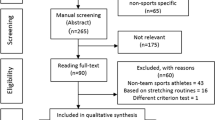Abstract
Seven subjects pedalled on a Monark cycle ergometer as fast as possible for approximately 7 s against four different resistances which corresponded to braking torques (T B) equal to 19, 38, 57 and 76 N · m at the crank level. Exercise periods were separated by 5-min recovery periods. Pedal velocity was recorded every 50 ms by means of a disc with 360 slots fixed on the flywheel, passing in front of a photo-electric cell linked to a microcomputer which processed the data. Every 50 ms, the time necessary to perform half a pedal revolution (t 1/2) was computed by adding the 50-ms periods necessary to reach 669 slots (the number of slots corresponding to half a pedal revolution). To measuret 1/2 to an accuracy better than 50 ms, this time was computed by a linear interpolation of the time-slot number relationship. Power (P) was averaged duringt 12 by adding the power dissipated against braking torque and the power necessary to accelerate the flywheel. The torque-velocity (T-ν) relationship was studied during the acceleration phase of a sprint against a single TB by computing every 50 ms the relationship between ν and T (N · m), equal to the sum ofT B and the torque necessary to accelerate the flywheel at the same time. The T-ν relationships calculated from the acceleration phase of a single all-out exercise were linear and similar to the previously described relationships between peak velocity and braking force. These relationships can be expressed as follows: ν = ν0,acc (1 −T/T 0,acc) where ν is pedal velocity,T the torque exerted on the crank andT 0,acc and ν0,acc have the dimensions of maximal torque and maximal velocity respectively. Based on this model, maximal power (P max,acc) is calculated as 0.257ν0, acc T 0, acc. Maximal powerP max,acc measured with the acceleration method was independent of braking torqueT B and slightly higher thanP max calculated from the relationship between peak velocity andT B.
Similar content being viewed by others
References
Bassett DR (1989) Correcting the Wingate Test for Changes in kinetic energy of the ergometer flywheel. Int J Sports Med 10:446–449
Fenn WO, March BS (1935) Muscular force at differents speeds of shortening. J Physiol (Lond) 85:277–297
Hill AV (1938) The heat of shortening and the dynamic constant of muscle. Proc R Soc B 126:136–195
Lakomy HKA (1986) Measurement of work and power output using friction-loaded cycle ergometers. Ergonomics 29:509–517
McCartney N, Heigenhauser GJF, Sargeant AJ, Jones NL (1983) A constant velocity ergometer for the study of dynamic muscle function. J Appl Physiol 55:212–217
McCartney N, Obminski JP, Heigenhauser GJF (1985) Torque-velocity relationship in isokinetic cycling exercise. J Appl Physiol Respir Environ Exercise Physiol 55:218–224
Nadeau M, Cuerrier JP, Brassard A (1983) The bicycle ergometer for muscle power testing. Can J Appl Sport Sci 8:41–46
Nakamura Y, Mutoh Y, Miyashita M (1985) Determination of the peak power output during maximal brief pedalling bouts. J Sports Sci 3:181–187
Peres G, Vandewalle H, Monod H (1981) Aspect particulier de la relation charge-vitesse lors du pédalage sur cycloergomètre. J Physiol (Paris) 77:10A
Sargeant AJ, Hoinville E, Young A (1981) Maximal leg force and power output during short-term dynamic exercise. J Appl Physiol 51:1175–1182
Sjogaard G (1978) Force-velocity curve for the bicycle work. In: Asmussen E, Jorgensen K (eds) Biomechanics VI-A. University Park Press, Baltimore, pp 93–99
Vandewalle H, Peres G, Heller J, Monod H (1985) All-out anaerobic capacity tests on cycle ergometers: a comparative study on men and women. Eur J Appl Physiol 54:222–229
Vandewalle H, Peres G, Heller J, Panel J, Monod H (1987) Force-velocity relationship and maximal power on a cycle ergometer; correlation with the height of a vertical jump. Eur J Appl Physiol 56:650–656
Vandewalle H, Maton B, Le Bozec S, Guerenbourg G (1991) An electromyographic study of an all-out exercise on a cycle ergometer. Arch Int Physiol Biochim 99:89–93
Author information
Authors and Affiliations
Rights and permissions
About this article
Cite this article
Seck, D., Vandewalle, H., Decrops, N. et al. Maximal power and torque-velocity relationship on a cycle ergometer during the acceleration phase of a single all-out exercise. Eur J Appl Physiol 70, 161–168 (1995). https://doi.org/10.1007/BF00361544
Accepted:
Issue Date:
DOI: https://doi.org/10.1007/BF00361544




